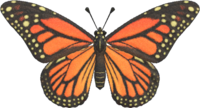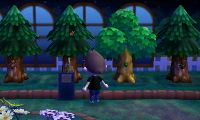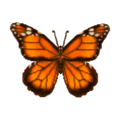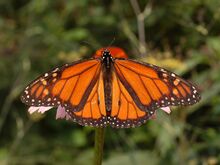Difference between revisions of "Monarch butterfly"
m (Reverted edits by Luckyflake99 (talk) to last revision by PanchamBro) Tag: Rollback |
AlexBot2004 (talk | contribs) m |
||
| Line 23: | Line 23: | ||
|price= 90 [[Bells]] <small>(Animal Crossing, Wild World, City Folk, New Leaf)</small><br>140 Bells <small>(New Horizons)</small> | |price= 90 [[Bells]] <small>(Animal Crossing, Wild World, City Folk, New Leaf)</small><br>140 Bells <small>(New Horizons)</small> | ||
}} | }} | ||
| − | The '''Monarch Butterfly''' ( | + | The '''Monarch Butterfly''' (known as the '''Monarch''' prior to {{NL|short}}) is a [[insect|butterfly]] that can be found in [[September]], [[October]], and [[November]]. It is very common. Like most [[bugs]], the creature sells for a considerably lower amount than all [[fish]] - in this case, lower than all of them. It is the only butterfly to appear during the [[autumn]] and one is of four bugs (itself, the [[Cricket]], the [[Bell Cricket]], and the [[Migratory Locust]]) to be limited to autumn. |
__TOC__ | __TOC__ | ||
| Line 39: | Line 39: | ||
{{CFBugInfo | {{CFBugInfo | ||
|number = 5 | |number = 5 | ||
| − | |image = Monarch | + | |name = Monarch |
| + | |image = Monarch CF Icon.png | ||
|catchphrase = I caught a monarch butterfly! To me, Your Majesty! | |catchphrase = I caught a monarch butterfly! To me, Your Majesty! | ||
|description = These are known for their ability to travel far -- in excess of 1,500 miles (2,400 km)! | |description = These are known for their ability to travel far -- in excess of 1,500 miles (2,400 km)! | ||
Revision as of 12:42, April 15, 2021
- "I caught a Monarch Butterfly! This butterfly can travel!" —Wild World
| ||||||
 | ||||||
| Real-world info | ||||||
|---|---|---|---|---|---|---|
| Name: Danaus plexippus Family: Nymphalidae - Emperors, admirals, tortoiseshells and fritillaries | ||||||
| Main appearances | ||||||
|
| ||||||
| Other appearances | ||||||
Names in other languages
オオカバマダラ
大桦斑蝶 Monarque Mariposa monarca Farfalla monarca Монарх
왕나비 大樺斑蝶 Monarque Mariposa monarca Monarchfalter Monarchvlinder | ||||||
The Monarch Butterfly (known as the Monarch prior to New Leaf) is a butterfly that can be found in September, October, and November. It is very common. Like most bugs, the creature sells for a considerably lower amount than all fish - in this case, lower than all of them. It is the only butterfly to appear during the autumn and one is of four bugs (itself, the Cricket, the Bell Cricket, and the Migratory Locust) to be limited to autumn.
Catch details
In Wild World
| 64px | ''In a group, they can migrate up to 1,850 miles (3,000 km)."
|
In City Folk
| Description | These are known for their ability to travel far -- in excess of 1,500 miles (2,400 km)! |
|---|---|
| Time of year | Sep – Nov |
| Time of day | Sep – Oct: 4 AM - 5 PM Nov: 8 AM - 5 PM |
| Peak times | Oct – Nov |
| Location | Flying near flowers |
| Bug size | 85 mm |
| Rarity | Uncommon |
| Selling price | |
| Furniture size |
In New Leaf
| Time of year | Sep – Nov All year (Tortimer Island) |
|---|---|
| Time of day | Sep - Oct: 4 AM – 5 PM Nov: 8 AM – 5 PM Tortimer Island: 8 AM - 5 PM |
| Peak times | Sep: 8 AM - 4 PM Oct - Nov: 8 AM - 5 PM |
| Location | Flying near flowers (can be found on Tortimer Island) |
| Size | 108 mm |
| Rarity | Common |
| Selling price | |
| Furniture size |
In Pocket Camp
| Availability | Not currently available
|
|---|---|
| Location | |
| Size | 103.0 mm – 112.9 mm |
| Rarity | ★ |
| Selling price | |
| Version added | Unknown |
| Villager gift data | Tier: Unknown
Rewards: Unknown |
In New Horizons
| Time of year | North: Sep – Nov South: Mar – May |
|---|---|
| Time of day | 4 AM – 5 PM |
| Location | Flying near flowers |
| Weather | Any except rain |
| Spawn requirement | Appears from the start of the game |
| Selling prices | |
| Furniture size |
Donating to the museum
In Wild World
- "The monarch butterfly got its regal name because of its orange coloring, wot? Yes, it reminded people of the king of England, aka William of Orange. To be perfectly honest, if I were His Highness, I'd be rather miffed! Blech! Truly, to have a filthy bug remind people of you... Absolutely appalling, wot!" —Blathers
The Monarch Butterfly can be seen in flying around the upper right corner of the first bug room, occasionally perching on flowers.
In City Folk
- "Monarch butterflies are quite colorful, aren't they? ...As it happens, the colors indicate they're poisonous! I certainly start to feel queasy when I look at one. Though that happens with all bugs..." —Blathers
After donation, it can be seen flying around on the upper tier of the insect exhibit.
In New Leaf

Upon being donated, the butterfly can be found in the room of the bug exhibit which has the light in the middle, resting on the tree which also is home to a Lantern Fly. The exhibit has this to say about the Monarch Butterfly:
"Monarch butterflies are known for their lengthy southward migrations in the winter. Once spring rolls around, they return to their original homes until the weather turns cold again. In their southern habitat during winter, you may see many thousands of them covering the trees."
In New Horizons
"Did you know the monarch butterfly migrates south for the winter and returns north for the summer? Indeed, these horrid orange beasties do not tolerate the cold and travel 3,000 miles to escape the winter. During the journey, they cluster together in trees by the thousands just to stay warm. Imagine! Hordes of the foul flittering fiends huddled together in one place! If only they'd put on tiny coats instead."
After donation, it can be seen flying around in the butterfly room.
Gallery
Real-world information
The monarch, sometimes known as the wanderer, is a milkweed butterfly with a wingspan ranging from 8.9 to 10.2 cm. Native to North America, the monarch can also be found in New Zealand, Australia, Portuguese archipelagos, and occasionally in Western Europe. Aside from their vivid orange coloration, the monarch is famous for its annual migration to and from North and South America, of which no single individual survives — the entire journey takes three to four generations of monarchs to complete. Due to their milkweed diet, the monarch is toxic, or at the very least distasteful to many would-be predators. The highest concentration of toxins can be found in the wings and abdomen of the monarch. The males have a brighter coloration than the females, and are slightly larger. Males also have two small black spots on their rear-wings [see picture], something that is not shared with females.
Names in other languages
| オオカバマダラ Ōkabamadara |
Monarch butterfly (lit. "birch milkweed butterfly") | |
| 왕나비 wangnabi |
Monarch butterfly | |
| 大桦斑蝶 dà huà bāndié |
Monarch butterfly (lit. "birch milkweed butterfly") | |
| 大樺斑蝶 Unknown |
||
| Монарх Monarkh |
Monarch | |
| Monarchvlinder | Monarch butterfly | |
| Monarchfalter | Monarch Butterfly | |
| Mariposa monarca | Monarch Butterfly | |
| Monarque | Monarch | |
| Farfalla monarca | Monarch butterfly | |
| Bugs | ||||||||||||||||||||||||||
|---|---|---|---|---|---|---|---|---|---|---|---|---|---|---|---|---|---|---|---|---|---|---|---|---|---|---|
| ||||||||||||||||||||||||||
| This article about a species is a stub. You can help Nookipedia by expanding it. |



